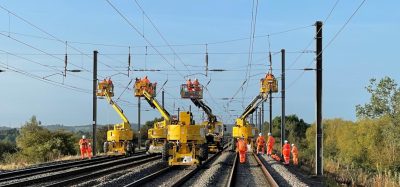Signalling: back on track and moving at pace to modernise UK rail
Posted: 30 August 2022 | Atkins, Fraser Greenwood | 1 comment
In this interview with Global Railway Review, Fraser Greenwood, Engineering Director for Signalling at Atkins, explains how the organisation is contributing to the delivery of a digital railway of the future for the UK.
What changes has Atkins seen in recent years?
Atkins has always been committed to playing an important role in delivering a digital railway that is fit for the future across the United Kingdom but in recent years, we have had to do some soul‑searching. How do we change and respond to the rail modernisation agenda going on around us, not just to remain competitive, but to strive to be the best in the rail signalling sector? Some tough decisions are paying off; we are now a healthy, profitable, forward-looking part of the wider Atkins and SNC-Lavalin business that is leading the way in the signalling sector, with safety and efficiency at our core, creating a future-proofed railway that is fit for the 21st century.
Atkins has always been committed to playing an important role in delivering a digital railway that is fit for the future across the United Kingdom but in recent years, we have had to do some soul‑searching.
It is no over exaggeration to say that internally, we have undergone a phenomenal transformation in only a few years. We have had to transform our processes, root, and branch, to adapt to the fact that we didn’t have our own equipment to configure, losing our USP in the process. We restructured, we took a close look at our business model, and we reinvented our entire strategy, shifting from measuring productivity to measuring effectiveness. We turned the situation around, to develop an award-winning technology solution, our Advanced Signalling Method (ASM), backed by a team that works in a more lean and agile way and that is aligned to a single objective: focusing on the end result and supporting our client to deliver a truly modern railway in the safest, most efficient manner possible.
I could write at length about the specifications of the signalling method we have developed, outlining its many features and innovations; the control centre interface and level crossings and interlockings and all the rest. It adopts modern software techniques, it is a modular, automated, and fully auditable ‘plug and play’ solution and it is the only EN50128‑compliant, ISA assessed, safety integrity level 4 signalling interlocking software process in the UK. What is important is the result of this technology. Has it modernised the railway? Does it improve reliability and journey times? Is it safer for workers on the track? And the answer is yes to all those questions.
Could you tell us more about Atkins’ signalling solution, and how technology has enabled you to improve reliability?
The ASM’s data production process removes human interpretation so it is more robust, learning is retained as part of continuous improvement and every aspect is fully auditable – all of which has a direct impact on reliability. Each component is factory-engineered, and each module is pre-tested off-site, which makes the whole process safer and more efficient as it reduces the need for the workforce to be trackside. The overall system is therefore more reliable, so train operators’ timetables – and therefore thousands of passenger journeys – are significantly less exposed to disruption.
In terms of its nuts and bolts – unwieldy Victorian mechanics have given way to 21st century data. The ASM integrates and controls interlockings, level crossings, control centre interfaces, remote condition monitoring and other associated products on one platform – and in one central location. For example, the lines connecting Norwich, Great Yarmouth, and Lowestoft (NYL), which we upgraded with ASM technology in 2020, previously had thirteen signal boxes along the routes, built in the 1800s, controlled by wires and rods and levers. Now all of that is controlled by one person sitting more than 60 miles down the track in Colchester, using a digital interface with state-of-the-art LED signals, digital axle counters all connected by fibre optic transmissions systems.
What benefits have you already realised as a result of the new ASM?
Having completed NYL, the East Anglian region now has the most modern signalling solution and safer level crossing systems for rail and road users in the UK, matching its new rolling stock and creating a comfortable service for passengers. Not only has this delivered obvious cost savings – the ASM is projected to reduce capital costs by 20 per cent and operational costs by up to 40 per cent – it also means the chance of things going wrong are very slim. In the rare situation that anything does malfunction or requires maintenance, all the equipment has been positioned in such a way that engineers on the ground can fix it safely. They no longer need to walk down the track for miles, but instead go to an access point and attend to the equipment quickly, and safely.
…we are taking our signalling business into new directions, keen to exploit the anticipated benefits that the Great British Railways plan for rail published in May 2021 will bring.
To date, the ASM has been successfully deployed across the UK network at Old Oak Common depot, the Norwich, Great Yarmouth, and Lowestoft lines in the east, the Shepperton Branch and Feltham Phase 1, plus Feltham Phase 2 in the southeast which was delivered this April – and the order book is filling up fast. We are in the process of delivering Feltham Phases 3, 4 & 5 and an enviable portfolio of level crossing renewals (using both our ASM and more “traditional“ solutions) and there are exciting times ahead; as part of the East West Rail programme, which will re-establish a rail link between Cambridge and Oxford, and improve connections between East Anglia and central, southern and western England, will soon have ASM fitted on the section that is connecting Bicester to Bletchley, taking an old Beeching closure line from the 1960s and creating a brand new, modern railway to meet current and future demand.
What are Atkins’ plans for the future?
Buoyed by this momentum, we are taking our signalling business into new directions, keen to exploit the anticipated benefits that the Great British Railways plan for rail published in May 2021 will bring. Specifically, a shift that will see us being able to work more closely and in tune with train operators. The plan states its intention to introduce a “simpler, more integrated structure [that] will cut duplication, increase Great British Railways’ purchasing power and economies of scale, and make it easier and cheaper to plan maintenance, renewals and upgrades” and we warmly welcome this opportunity. If we are able to work with train operating companies further in advance, we could get so many more upgrades delivered, with much less disruption, saving so much valuable time and money.
Over the past two years we have transformed Atkins’ signalling business into a much more lean and effective operation that is delivering the very best in class of modern signalling technology for our customer. We are helping trains run on time and we are keeping railway workers safer. From this sustainable model of digital-first delivery we want to keep going on an upward trajectory, scaling up or down according to demand, staying lean and innovative and providing the best value for money, by adopting a managing contractor structure and using our ASM. We believe this will make us unique in the railway signalling industry and strengthen not just our position further, but also our proposition. The good news is, for passengers up and down the UK, we are on-track to continue modernising the UK’s railway and reach our collective destination.











Very thought provoking Fraser. A really good example of the benefits that can be achieved when the signalling system as a whole is considered from the start.